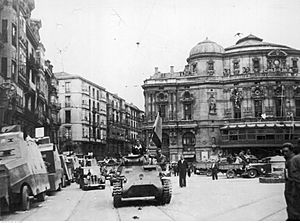Battle of Bilbao facts for kids
Quick facts for kids Battle of Bilbao |
|||||||||
|---|---|---|---|---|---|---|---|---|---|
| Part of the Spanish Civil War | |||||||||
 The Northern Front. Bilbao is on the right of the red area. |
|||||||||
|
|||||||||
| Belligerents | |||||||||
| Commanders and leaders | |||||||||
| Strength | |||||||||
| 50,000 troops and militia | 60,000 Nationalist troops 15,000 Italian troops |
||||||||
| Casualties and losses | |||||||||
| Unknown | Nationalist Spain: Unknown Italy: 105 dead 427 wounded three missing |
||||||||
The Battle of Bilbao was a major event during the Spanish Civil War. It took place in June 1937. In this battle, the Nationalist Army captured the city of Bilbao. They also took control of the rest of the Basque Country. This area had been held by the Republic.
Contents
Why Was Bilbao Important?

Bilbao was the capital city of the Basque area. This area had its own government. The Republic set it up after the war started. This was to thank the Basque nationalists for their support.
The Basque people live in four main areas in Spain. These are Navarre, Álava, Gipuzkoa, and Biscay. The Basque nationalists were very strong in Gipuzkoa and Biscay. But Navarre and Álava supported the Nationalists.
How Did the Nationalists Get Close to Bilbao?
Early in the war, the Spanish Nationalist troops took over Gipuzkoa. They captured Irún in August 1936. Then they took San Sebastián in September 1936. This cut off the Basque Country from the French border. It also isolated the northern Republican areas.
On March 31, 1937, the Nationalists started a big attack. General Emilio Mola led this attack on Biscay Province. The Basque troops had to retreat. By June, the Nationalists were very close to Bilbao. They were right outside the city.
The Battle for Bilbao
By June 11, 1937, the Basque forces had moved back into the city of Bilbao. The city was protected by a line of defenses. These defenses were called the "Bilbao's Iron Ring".
What Was the Iron Ring?
The Iron Ring was built quickly. But it was not very well designed. It was an old-fashioned type of defense. It was like the forts used in World War I. This meant it was weak against modern weapons. Things like airplanes and powerful cannons could easily break through it.
Also, the Iron Ring was meant to be defended by 70,000 soldiers. But only 30,000 troops were there to defend it. Because of these problems, the Nationalist forces broke through the Iron Ring quite easily.
The Attack on the City
The Nationalists broke through the Iron Ring with a strong attack. Their soldiers pushed forward. They were supported by heavy bombing from the air. They also had many cannons firing (150 guns and 70 bombers).
On June 12, the Republican army tried to distract the Nationalists. They launched an attack somewhere else, near Huesca. But the Nationalist troops kept moving forward toward Bilbao.
On the night of June 13, the defenders moved most of the people out of the city. This was to keep them safe. On June 18, General Ulibarri pulled his remaining troops out of Bilbao. The Nationalists then took over the city the next day, June 19. The city's bridges were destroyed to slow down the attackers. But most of the city itself was still standing.
See also
 In Spanish: Batalla de Bilbao para niños
In Spanish: Batalla de Bilbao para niños

